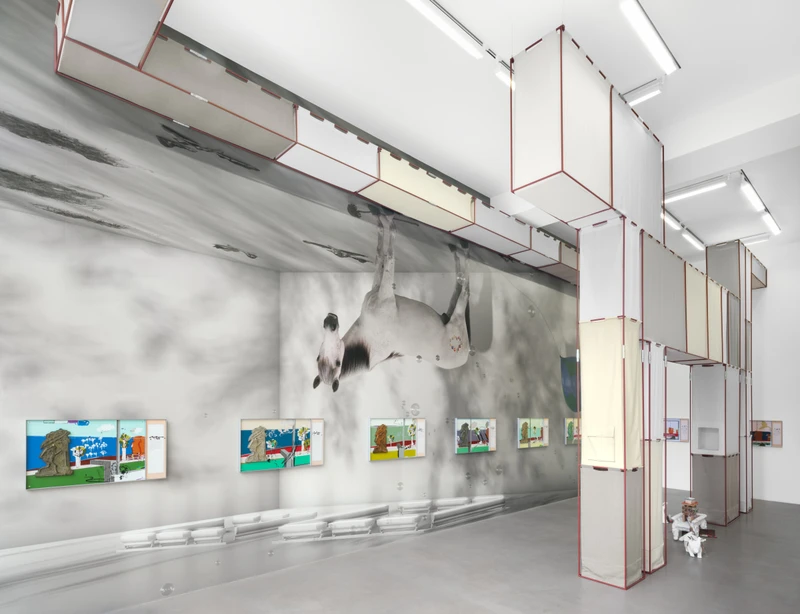Helen Marten: Third Moment Profile | The Almost Horse
14 Sep-29 Oct 2022


The exhibition’s own folly is classical: the attempt to depict a horse. This exertion unfolds in three ways: a monumental photographic wallpaper, an architectural scaffold, a fictional tale. In each instance, a reckless inaccessibility deliberately foils any practical realisation of the subject at hand. The horse is not realised in language, not realised in form, not realised in image. Instead, the threat of linear time is suspended, confused, or even violated, because the idea “horse”, almost arbitrary, is resistant to conventional capture and closure.
On large wallpaper, a photographic image of a white horse stands occupying what looks to be the Davies Street gallery. The image is upside down, the horse hanging static and luminous. The horse is a real horse, documented inside the gallery space several months prior but the image-space it stands in is a mutant, a new construction of CGI treachery, skewed and altered to produce the perspectival artifice of an additional spatial dimension. Looking from outside through the gallery’s large glass window, the inverted planes where the walls and floors meet produce the effect of a new elongation, artificially suggesting the illusion of a much wider additional room. There is no obvious functional appropriateness to this gesture, other than reinforcing the condition of distrust in an image’s initially yielded message. The horse itself is a problem of gesture and analogy, surrounded by motifs of soundless instability: a planet Earth balloon; soap bubbles; dust and fauna debris. Imagining the horse as both contemporary cipher and ancient mythological signifier, there are no surprises then that the etymological root of image is linked to imitation: imaginative meaning accumulates.
Twenty-six paintings of identical scale are hung in an equally spaced circuit around the periphery of the gallery. A glib bronze temperature gauge in the form of a frog with downturned mouth and raised umbrella is repeated in sequence across each of the paintings. Each depicts a replicated view through a window onto a classic Romantic landscape. The scene is torturous in its repetitive similarity. Each painting has been made using snapshots captured from a real 3-dimensional model moving in multiplane fashion through the constructed landscape. These fictional renderings of signs – trees, fences, clouds, cliffs – become more than the simple possibility of existence of the great labour force of nature continually producing objects of human and social utility, but part of the trompe l’oeil effect of privileging mobility over stasis.
These paintings also house a single “page” fragment of a fictional story written by the artist. Each paragraph begins with the next consecutive letter of the alphabet, an A-Z circuit whose narrative tells of the generative friendship of two strangers and their horse. The typography is punctured with falling leaves, 26 scattered over the beginning A, 0 at the concluding Z, meaning that a full seasonal cycle has flushed and then ended with the narrative closure of the story, the alphabet exhausted.
Built from red oxide steel and sewn fabric sacks, the largest horse evocation is the most aesthetically economical. Clad in beige and cream, the sculptural logic is similar to that of a tent, harnessing with its slender minimalism an emotional abruptness. Straight tendons are held in place alongside taut fabric, sometimes pockets, sometimes cables. The horse form they seek to diagram belongs to the rudimentary space of early computer rendering – the straight line before the eloquence of a curve seemed possible. A tent is an ensemble of parts, elements in a tensile mix that rely on one another for stability. And this wildly oversized horse, like foliage, like pillar or vault or any other arborescent example of architecture, is tethered downwards by the directional core of its feet, from which numerous possible lines and faces spring: the tail is long; the long tale continues.
There are 26 paintings with cast bronze; 1 immersive architectural structure; 1 floor-based sculpture and 1 wallpaper.
Helen Marten lives and works in London. Marten studied at the University of Oxford and Central St. Martins, London. In 2016 she was awarded the Tate Turner Prize and The Hepworth Prize for sculpture. Marten works across sculpture, painting, video and writing. Her work is included in the collection of The Museum of Modern Art and Guggenheim Museums and Foundation, both New York; Tate, London; Stedelijk Museum, Amsterdam; Moderna Museet, Stockholm; Hirshhorn Museum, Washington DC and Walker Art Center, Minneapolis, amongst others. She was included in the 55th and 56th Venice Biennales and the 12th Lyon Biennale. Her first novel, The Boiled in Between, was published by Prototype in September 2020. She is currently at work on her second novel, A Polite History of Vandalism.